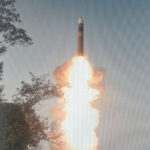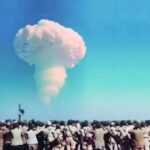North Korea and the Clock
By Kennette Benedict | June 8, 2009
When the Bulletin last moved the hand of the Clock closer to midnight in January 2007, we noted our worries about what North Korea’s nuclear arsenal might portend for future arms races in Northeast Asia and for further unraveling of the Nuclear Non-Proliferation Treaty (NPT). We viewed North Korea’s program, along with Iran’s uranium enrichment program for civilian nuclear power, the failure to adequately secure nuclear materials around the world, and the enormous nuclear weapon stockpiles in the United States and Russia as “symptomatic of a larger failure to solve the problems posed by the most destructive technology on Earth.”
The Bulletin monitors developments around the world to track trends and events that contribute to a more dangerous or a safer world. Since January 2007 when the Bulletin Board of Directors moved the hand toward midnight–a metaphor for the end of civilization–positive steps have been taken that may partially balance the trends indicated by a nuclear-armed North Korea. Among encouraging signs are the public calls by former government officials in the United States, Britain, Germany, Australia, and elsewhere, for a “world free of nuclear weapons.”
Perhaps even more significant is that, for the first time, a sitting U.S. president is taking steps to fulfill Washington’s pledge under the NPT to begin nuclear disarmament with the publicly announced goal of achieving a nuclear-weapons-free world. The subsequent U.S.-Russian negotiations to reduce nuclear arsenals under a new bilateral treaty are proceeding well with a progress report scheduled for July and a signing deadline set for December 2009. Furthermore, the new pact will include provisions for verification and inspection, and may address the issue of national missile defense.
Even more encouraging is a subtle but marked shift in the public discourse about nuclear weapons–from talking about these arsenals as necessary to national security, to thinking about them as a problem and obstacle to security. As so many have understood, including leaders as varied as Dwight D. Eisenhower, Mikhail Gorbachev, Ronald Reagan, and now Barack Obama, these are weapons of genocide that have no place in a world that prohibits genocide.
But these developments don’t mean that the world is safe from nuclear catastrophe. Far from it. Still worrisome is the fighting and turmoil in Pakistan, which possesses an estimated 50 nuclear weapons and missiles capable of hitting major cities in India. If nuclear weapons are a problem in stable countries, the risks are compounded many-fold in a politically violent maelstrom, such as the situation in Pakistan, where fighting over the legitimate control of the instruments of state has broken out.
Clandestine trade in nuclear weapons material and technology continues without adequate international inspection and investigation. Unfortunately, the International Atomic Energy Agency labors without enough funding and expert staff to monitor with confidence even the lawful commerce in civilian nuclear power technology. So diversion of highly enriched uranium or plutonium to groups bent on catastrophic disruption and mass killing is still a real possibility.
Finally, the United States and Russia continue to maintain their nuclear forces at a high state of launch readiness, still capable of conducting all-out nuclear war every minute of every day, even as they negotiate in good faith to reduce, dismantle, and lock away their nuclear bombs.
So, is the world safer now than it was two years ago? Perhaps not, but the major powers–the first inventors of nuclear bombs–are trying to shed the enormous arsenals they built up over 60 years of reckless hostilities. From a high of nearly 70,000 warheads in the mid-1980s, Russia and the United States are more than halfway to zero. It then would be among the most terrible ironies of history if an arms race in Northeast Asia began just as the first nuclear arms race between the United States and Russia was winding down. Such a regional nuclear weapons competition might even stimulate arms races in other regions, e.g., the Middle East.
With even the hint of such possibilities, it’s clear that humanity is still imperiled. Without robust cooperative efforts to bring nuclear weapons and material under control, and the enforcement of effective laws to prohibit their production and use, we still face catastrophe from the most dangerous technology on Earth. The Clock is ticking.
Together, we make the world safer.
The Bulletin elevates expert voices above the noise. But as an independent nonprofit organization, our operations depend on the support of readers like you. Help us continue to deliver quality journalism that holds leaders accountable. Your support of our work at any level is important. In return, we promise our coverage will be understandable, influential, vigilant, solution-oriented, and fair-minded. Together we can make a difference.
Topics: Nuclear Weapons, Opinion















